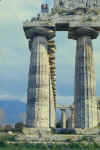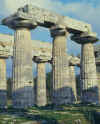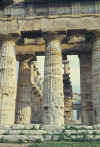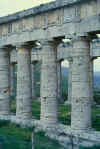ARCHAIC GREECE: KEY TERMS AND DISCUSSION QUESTIONS
1. HOMER'S ODYSSEY offers a
sharper vision of order, justice, and the norms of civilized life - as
the Greeks understood them. The poet struggles to relate his poem to
the Iliad, with different visions of the hero's values and of
storytelling. He presents diverse and contrasting stories, told by
different narrators, and challenges his audience to distinguish truth
from falsehood. His concern with order and his awareness of a range of
viewpoints herald the work of Hesiod, the inquiries of Ionian
philosophers, and the different voices of the lyric poets.
2. ARCHAIC CULTURE: POETS AND PHILOSOPHERS
-HESIOD (c. 700 B.C.): author of THEOGONY, an account
of the origins and genealogies of the gods and goddesses, and WORKS
and DAYS , a didactic poem providing practical and moral
instruction.
-LYRIC POETS of the seventh and early sixth centuries B.C.:
ARCHILOCHOS , SAPPHO, SOLON
-the IONIAN PHILOSOPHERS (“PRE-SOCRATICS”) of the sixth
century B.C.: THALES, ANAXIMANDER, ANAXIMENES
3. ANCIENT ARCHITECTURE AND THE GREEK TEMPLE
-What distinguishes the temple from other forms of ancient Greek
architecture? What makes it “monumental”?
-What is the function of the Greek temple? How is it different
from religious buildings with which you are familiar? How does
the function of the Greek temple affect its form?
-What sources influenced the design of the earliest stone temples in
Greece?
-What are the "ORDERS"? What are the differences in the
overall appearance of the Doric and Ionic temples? How do
individual elements contribute to those differences?
-Why did the form of the Greek temple change so little in the 6th and
5th centuries B.C.?
-How were mathematical proportions used in the Greek temple?
-What are the "REFINEMENTS" and what purposes do they serve










LEARN THE MAIN PARTS OF THE PLAN OF THE GREEK TEMPLE, THE
ELEMENTS
OF THE
DORIC (
DRAWING ) AND
IONIC (
DRAWING ) ORDERS, AND THE MAIN DIFFERENCES BETWEEN THE
ORDERS
Elements of the plan:
cella ,
opisthodomos ,
pronaos
Elements of the elevation:
stylobate ,
column ,
capital
,
entablature
,
architrave ,
frieze ,
metope ,
triglyph ,
pediment
4. THE EARLY DEVELOPMENT OF THE ATHENIAN POLIS AND ITS
INSTITUTIONS
-DRAKON (c. 621 B.C.): first Athenian law code
-SOLON (c. 594 B.C.), poet and statesman: economic reforms
(elimination of debt slavery, cancellation of debts) and constitutional
reforms (creation of four classes based on wealth not birth/rights and
eligibility for office were determined by class membership);
development of three-tiered political structure (AREOPAGOS, COUNCIL
OF 400, ASSEMBLY)
5. TYRANNY IN SIXTH-CENTURY ATHENS AND ITS AFTERMATH
-the TYRANTS: PEISISTRATOS (c. 561 B.C., 559-556 B.C.,
546-527 B.C.) and his sons, Hippias (c. 527-510 B.C) and Hipparchos:
building programs on the Acropolis and at other sites, first Athenian
coinage, Athenian domination of the market for black-figure pottery,
development of red-figure pottery, incorporation of the Homeric poems
into the festival of the GREATER PANATHENAIA , and development
of the CITY DIONYSIA festival
-KLEISTHENES (c. 508 B.C.): political reorganization of the
polis (creation of ten tribes, each including DEMES from the
city, the hill country and the coast; creation of the COUNCIL OF 500;
possible introduction of OSTRACISM)
6. THE PERSIAN WARS (described in HERODOTUS’ HISTORIES)
-490 B.C., Persian army of king DARIUS defeated by the
Athenians at MARATHON
-480/79 B.C., king XERXES' invasion; the Persians
defeated the Spartans at THERMOPYLAE, despite their heroic
defense.
After the Persians sacked Athens, the Greek fleet, led by the
Athenians, defeated the Persian fleet at SALAMIS and the
Persians were defeated on land at PLATAEA.
DISCUSSION QUESTIONS: THE STORY OF SOLON AND
CROESUS
-What is Solon’s advice to Croesus?
-What does Herodotus mean when he says “nemesis fell upon Croesus”?
-What is the lesson of the story of Croesus’ son, Atys?